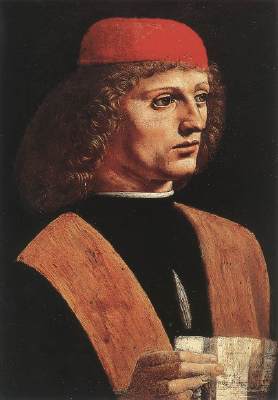Pythagoras
( 569 - ca 475 f. Kr)
Pythagoras was born on the Greek island of Samos around 560 BC. Because of a political disagreement he fled to the Greek colony of Croton on the Italian mainland. He started a philosophical cult. There are no books left from his hand.
Before he formulated the famous equation, that has his name, he studied music. His opinion was that there is a divine relation in music which also could influenced the planets. And the planets actually made music in their orbits.
Pure fifth
If you double the length of a string, you get a tone that is one octave lower, if you make it 3/2 longer you get a fifth lower. If you make it 4/3 longer you get a fourth lower.
Pythagoras was interested in the numbers 1,2,3,4. (the tetrakys) The sum of these numbers yields 10.
Archytas
(428-350 BC)
Archytas was a great mathematician of the Pythagoras school and a friend of Plato. There are no books left from him. He divided the scale into 5 whole tones on 9/8 (the difference between the fourth and the fifth). and two semitones of 356/243. The semitones are called leimma (help intervals). Archytas made some different scales based on the epimoric ( n+1)/n relation ship.
Aristoxenus
(ca. 350 BC. - ?)
Aristoxenous lived at the same time as Aristotle. He held that the notes of the scale are to be judged, not as the Pythagorean held, by mathematical ratio, but by the ear. Aristoxenous wrote 420 books, three of them are The only work of his that has come down to us is the three books of the Elements of Harmony, an incomplete musical treatise.
Didimus
(ca. 50 BC- ? )Didimus suggested a scale which is very close to "Just Temprament". by dividing the major third (6/5) into a 9/8 whole tone and a small whole tone of 10/9.
"The comma Didimus" (81/80) can be experience if you tune your violin with pure fifth and take the first finger on the a string and play it with the E-string. You must move the finger down about 3 mm (81/80 of the string length) to get a pure sixth with the D-string.
Claudius Ptolemaios
(83 - 161 BC)
Ptolemy lived in Alexandria in Egypt in the first century AD. Ptolemy wrote an work Harmonics on music theory. He criticized the approaches of his predecessors, Ptolemy argued for basing musical intervals on mathematical ratios backed up by empirical observation (in contrast to the overly-theoretical approach of the Pythagoreans). He presented his own divisions of the tetrachord and the octave, which he derived with the help of a monochord.
Severinus Boethius
(480 - 524 BC)
Boethius wrote about the Pythagorean harmony. Unfortunately he mixed origin of the scales. While the ancient Greeks described the scales descending, Serinus Boethius wrote the scales ascending
The so called ecclestical modes got the same names as the ancient Greek scales but the names cover other scales.
Pope Gregorius the Great
(590-604 e. Kr)
Gregory is known for describing the 7 sins of death. He also founded the western European polyphonic singing by starting the choir singing in the churches and monasteries called the Gregorian song
Guido de Arezzo
(995 - 1050)Guido made a system of 6 notes Ut, Re Mi Fa So, La after the 6 first notes in a famous hymn..
UT queant laxis resonare fibris Mira gestorum famuli tuorum, Solve polluti labii reatum, Sancte Joannes. Arezzo At the time of Guide de Arezzo the theory of harmony started to forget the ancient theory which build on two tetrachords.
Franchino Gaffurio
(1451 - 1522)
The Italian composer Gaffurio read the old Ptolemy thretise and founded thereby the modern teaching of harmony.
Gioseffe Zarlino
(1517- 1590 )
Italian composer Zarlino was inspired by Gaffer to study the ancient teaching of harmony. He found that the 6/5 relation (the third) was very important.
Vincencio Gallilei
(1520-1591)
Vincencio was father to the famous Gallielei who threw two balls from the leaning tower of Piza.
Christian Huygens
(1629-1695)
Duch Astronomer. Divided the scale into 31 intervals
Marin Mersenne
(1588-1648)
Mersenne was French mathematician.. In the year 1635 he describes how the 12th root of 2 can make a tempered scale. Mersenne believes more in the just intonation scale. He is the first person to describe this scale.
Andreas Werckmeister
(1645 - 1706)Werkmeister found a practical way of making a tempered tuning by counting the beats. It was based on this tuning that Johann Sebastian Bach wrote "Das Wohltemperierte klavier" a musical piece that modulates through all 12 keys. This piece could not be played on a just or Pythagorean tuned instrument. Thereby the dispute was solved and the instruments became tempered tuned.
